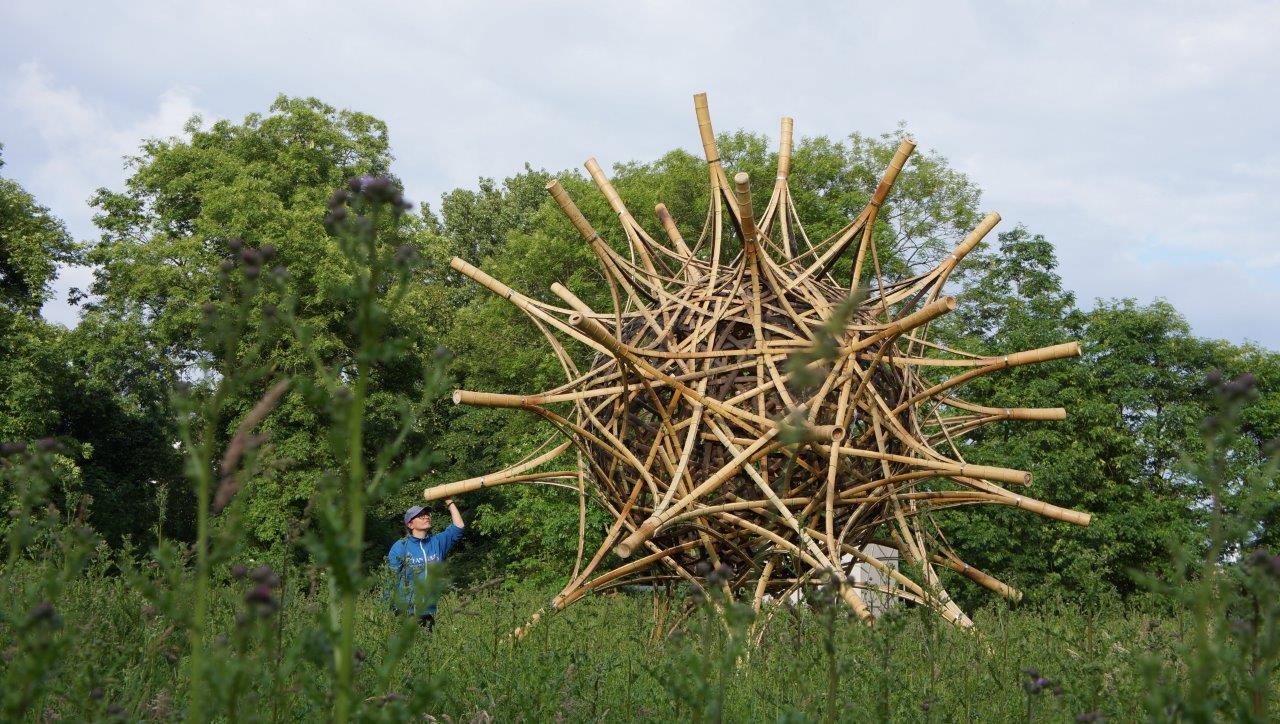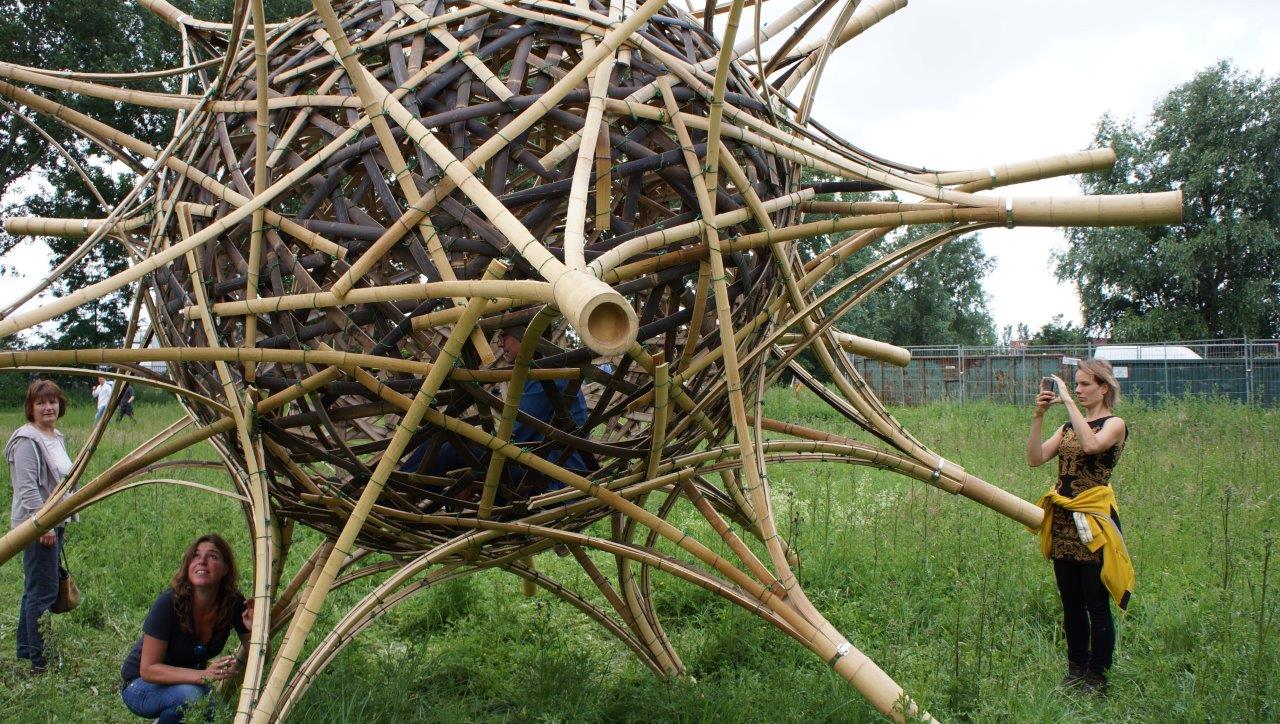Tumble Temple
|
Tumble Temple A dynamic sculpture – metaphorical to tumbleweed. The construction is a cocoon made of naturally strong bamboo. Its exterior side has extensions with which it can move and protect the inner space. The structure is made of splits from black Wulung and yellow Moso bamboo.   PROJECT INFORMATION: The sculpture ‘Tumble Temple’ was one of 25 sculptures presented at the 2016 exhibition ‚In Quarantaine‘ on the terrain of the former ‘Quarantaine-Inrichting’ in Heijplaat, Rotterdam. The movable structure was designed and built by the designer and artist Elena Goray and the architect and bamboo entrepreneur Christoph Tönges (CONBAM). The subject of ‘In Quarantaine’ was HERMITAGE. “Most people will link the word Hermitage to the impressive palace in St-Petersburg (1762), which was used by the tsar family as winter residence and later on became a national museum (with nowadays auxiliary branches in other countries). The word Hermitage origins from a small pavilion, an outbuilding, which was called the hermit’s cell (=hermitage). This project aims to give the word Hermitage its original meaning again.” Read below for further explanations about the requirements for the design topic and explanations about hermitage. Goray and Tönges created an organic sphere made of several chaotic layers of bamboo strips. All around were integrated bamboo pillars added, elevating the sphere off the ground. Accessed through a little opening, the sculptures form allows the insides hermit to move around by “walking it” without touching the ground. Artistic statement: A dynamic sculpture – metaphorical to tumbleweed. Detached from its roots and tumbling away in the wind, it represents a path of migration and self-discovery. The construction is a cocoon made of naturally strong bamboo. Its exterior side has extensions with which it can move and protect the inner space. Materials: The structure is made of splits from black Wulung and yellow Moso bamboo. The connections were realized with metal wires and clamps. BACKGROUND INFORMATION: Requirements for the design of HERMITAGE for ‘In Quarantaine 2016’: Artists, designers and architects were requested to design their own hermitage. The idea is to place the hermitage, hermit’s cell, in the modern world. There are no limitations with regard to shape and material, as long as it was manageable and safe to visitors. 3D designs, installations and virtual presentations were allowed. Although a limited number of indoor spaces were also available, we focused on outdoor 3-dimensional work. What is the perfect hermitage of 2016? Can we really turn inwards upon ourselves? An overload of information, social media and high workload frustrate people in their search of personal balance. There is an increasing need for individual idyllic places outside the busy world. We do meditation, yoga, Mindfulness training and build grown-up huts in our gardens. It is obvious: Our heads are full, we need resting-places to “recover” and temporarily disconnect from our busy/stressed existence. In the almost heavenly surroundings of the quarantine area, in the middle of the Port of Rotterdam, we wish to represent this need and dwell on the really necessary aspects of our existence. Location QI The ‘Quarantaine- Inrichting’ already constitutes a hermitage in itself, a green enclave in an industrialized environment. For the exhibition we will use the specific characteristics of the location; the seclusion of the private ‘Quarantaine-Inrichting’ and the contrast with the industrial environment. The QI terrain offers exhibitors almost unlimited possibilities to realize a design. It has an outdoor space (3 ha) with partially cultivated, partially wild green and a beach at the Maas. In the buildings you will find huge ateliers and small rooms. Context location 2014, 2015 Heijplaat 100 years In that same period the neighbouring residential area Heijplaat will celebrate its 100st anniversary. This residential area is developing into a future city harbour area. Concept House Village 2011-2018 A part of the district serves as a test area for experimental sustainable house-building; Concept House Village. In 2015 a couple of experimental houses will be realized, which will draw (inter)national attention. RDM-terrain The RDM-campus offers education, varying from LBO (lower vocational education) to HBO (Higher vocational education), amongst others the Academy for Architecture and companies for new productdevelopment. During the past 4 years Museum Boymans, in close cooperation with Havenbedrijf Rotterdam, organized international summes exhibitions in the submarine hangar. At the moment, these hangars are renovated. They will be available for exhibitions and events in 2015 again. We aim to link our project to activities at the RDM. Future Expectations are that Heijplaat in the coming years will develop into a popular city harbour area by 2020. The historic part of Heijplaat is a garden village from the beginning of the twentieth century and has been designated as a protected historic cityscape. In the meantime the QI-terrain has become a National Historical Monument, as last ‘Quarantaine- Inrichting’ of the Netherlands. About HERMITAGE: Hermitage means: hermit’s existence, in seclusion, living outside the civilized world.The word hermitage stems from Christian cultural history. The word derives from the Greek word ‘erimos’, which means desert, solitary, uninhabited, deserted. The Christians in Egypt, who were fleeing persecutions within the Roman Empire in the 2nd century AD were the first persons to be called hermits. They secluded themselves in the Sahara desert, just outside the town Wadi el Natrun. In this desert they discovered that life in solitude and peace, without possessions, with limited food, drink and sleep positively influenced religious experiences. A hermit lives in solitude, in a limited space, a hut, a cave, a ‘hermitage’ in a vast landscape. The limited space stimulates the hermit to connect with his soul: the unlimited landscape stimulates the hermit to experience connection with the wider context. RELATED: and: |